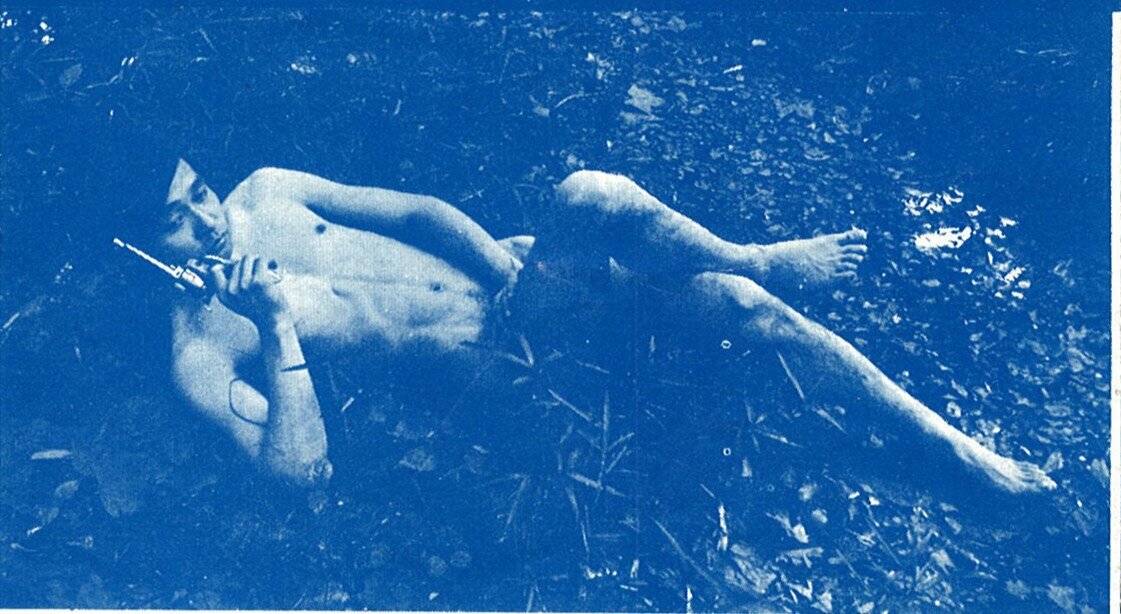
Essay: Crazy Love Forever! A Remembrance of Michio Okabe
Researcher Shuhei Hosoya’s text on filmmaker Michio Okabe.
Article: Shuhei Hosoya / 細谷修平
Crazy Love Forever! A Remembrance of Michio Okabe
A leaflet from “Mischief of Michio Okabe,” a screening at Theater Scorpio, Shinjuku, Tokyo.
The filmmaker Michio Okabe died in September 2020. Okabe was born in Tokyo in 1937, and after graduating from Keio University began his career as an artist in the mid-1960s, showing work in the Independent Exhibition ’64, in a solo exhibition at Naiqua Gallery and elsewhere. After being profoundly impressed by Kenneth Anger’s Scorpio Rising, he made his first film Tenchi Sōzōsetsu (The Doctrine of Creation) in 1967 and won an award at the Sogetsu Experimental Film Festival. Okabe subsequently produced Crazy Love (Kureijī rabu, 1968), Camp (1970) (in Japanese “貴夜夢富,” a phonetic rendering of the word “camp” in kanji characters meaning “precious night, wealth of dreams”), Shiro, Where Are You Going (Shiroyo Dokoe Iku, 1970), Boy-Taste (Shōnen Shikō, 1973), Diary of a Year (Saijiki, 1973), and Memoirs (Kaisōrōku, 1977). In addition to being a standard-bearer of the Japanese underground film movement, he continued to write visionary fiction, and his Fantasy Stories: Under the Floor of a Barbershop (Gensō Shōsetsu-shu: Ii Tokoya No En No Shita, Nagasaki Shuppan) was published in 2006.
In recent years several of his films have been transferred to digital formats, and the Philadelphia-based nonprofit organization Collaborative Cataloging Japan streamed Crazy Love online in November 2020, followed by The Doctrine of Creation and Camp in December. International critical reappraisal of Michio Okabe’s work is advancing, but understanding and discussion of Okabe and his work are still quite inadequate.
Crazy Love was released in 1968, a historical moment when political struggles and cultural movements were emerging and intersecting worldwide. At the beginning of the film, theater curtains open and members of the Zero Jigen (Zero Dimension) group, known for staging iconoclastic public “Rituals,” appear to the strains of “Words” by The Monkees. We are pulled from the auditorium through the proscenium arch and into the streets of Shinjuku. The film swiftly delivers shocks of realization of how dogmatically genres such as art, film, and music are categorized. Throughout it features scenes of young people in action and the sounds of The Beatles, James Brown, The Shamrocks and so forth, with the effect of dismantling existing cinematic concepts and expanding cinema to an extraordinary extent. During a scene where the Butoh dancer Mitsutaka Ishii performs to songs such as “Beatori ne-chan” (Young Miss Beatrice) sung by Rikizo Taya, we come to recognize the film as a drama fusing a Pop sensibility and a melancholic worldview. Meanwhile, we remain gripped by the sequence of ever-changing shots and the rhythmic sound.
The film is also brimming with primal and captivating eroticism, with young people rolling around and embracing on the streets of Shinjuku, and Rikurō Miyai transforming from man to woman to a soundtrack of Vicky Leandros’ “Casa Bianca” (White House). Real situations are skillfully decontextualized and deviate from expected norms: a man in a helmet, who appears to be a student protestor, and a police officer walk through the streets arm in arm and enter an old-fashioned love hotel, and footage of Kwon Hyi-ro [the perpetrator of a notorious hostage-taking incident] is scored with “The James Bond Theme.” There are also appearances by many underground actors playing various roles, including a Tokyo Gas employee (Shuzo Adachi Gulliver), the “gunman at sunset” (Kenji Kanesaka––[a reference to the Japanese title of Sergio Leone’s For a Few Dollars More]), an older man selling roasted sweet potatoes on the street (Jushin Satō), and others playing themselves––Akio Suenaga, the Kokuin (Heralding Shadow) group, Vitamin Art’s Tetsuo Koyama, Chida Ui, and Michio Okabe himself. In one scene, police burst into a room containing artist Genpei Akasegawa’s “zero-yen notes.” Hitomi Watanabe, who shot the University of Tokyo protests, participated in the filming.
The first time I saw Crazy Love, Okabe was seated next to me. Once the film started rolling, he was laughing harder than anyone else, and I believe no one enjoyed the film more fully than Okabe himself. I learned from Okabe that independent film means the pursuit of total freedom, also known as anarchy.
Now that Okabe is gone, what remains is his body of films. In the future, other films will be digitally transferred and we will have much more of his work to engage with. I am sure this will be both a great task, and a great deal of fun for all those involved.
Zeo Jigen (Zero Dimension) during the shooting of Crazy Love. Photograph: Yukio Kitade. ©Zero Jigen Kato Yoshihiro Archive
*This is a translation of an article, originally published in Japanese in issue no. 10 of the monthly magazine Anarchism, with additions and revisions.
Shuhei Hosoya
Born in 1983, Shuhei Hosoya is a scholar on art and media, as well as a videographer. He is chief representatives of the Zero Jigen Katō Yoshihiro Archive, as well as the HM Archive which holds materials by Minoru Hirata. After he studied symbolic iconography, and book and film editing at university, Hosoya is engaged in art documentation through interviews and research of artists’ practices. His main research field is art and politics, as well as media in the 1960s, about which he has published videos and books, and organized symposia. After the Great East Japan Earthquake in 2011, Hosoya continues his thinking and practice on art and documentation. Further, he was responsible as the special researcher for the Zero Jigen Collection for the Performance Art Archive at Asia Culture Center in Gwangju, Korea. His co-authored works include: Shibusawa Tatsuhiko Again (Kawade Shobo Shinsha, 2017), Japanese Terror: Era of Bombs 60s-70s (Kawade Shobo Shinsha, 2017), Peninsula Theory (Kyobunsha, 2018).
クレイジー・ラブ・フォーエバー!——追悼・岡部道男さん
細谷修平
2020年9月、映画作家の岡部道男さんが逝去された。岡部さんは1937年、東京生まれ。慶應義塾大学を卒業後、60年代半ばより美術家として活動を開始し、「アンデパンダン’64展」や内科画廊における個展などで作品を発表した。ケネス・アンガーの『スコピオ・ライジング』に衝撃を受け、67年に第一作『天地創造説』を制作。草月実験映画祭で奨励賞を受ける。以降、『クレイジー・ラブ』(68年)、『貴夜夢富(キャンプ)』(70年)、『シロよどこへいく』(70年)、『少年嗜好』(73年)、『歳時記』(73年)、『回想録』(77年)を発表。日本のアンダーグラウンド・フィルム運動の旗手として活動した。また、幻想小説の執筆も続け、06年に『〈幻想小説集〉いいとこ床屋の縁の下』(長崎出版)を刊行している。
近年には映画作品の数本がデジタイズされ、2020年11月には『クレイジー・ラブ』、12月には『天地創造説』、『貴夜夢富(キャンプ)』が、フィラデルフィアの非営利団体コラボラティブ・カタロギング・ジャパンのオーガナイズでオンライン上映されるなど、国際的な再評価が高まっている。しかし、わたしたちは岡部道男とその作品を捉えること、語り合うことがまだまだ足りていない。
『クレイジー・ラブ』は、政治闘争と文化運動が世界的に高揚し、互いを横断した68年に放たれた。映画の冒頭、シアターの幕が開き、街頭で儀式をする〈ゼロ次元〉がザ・モンキーズの「恋の合言葉(Words)」に乗って登場。わたしたちは観客席からプロセニアムアーチを越えて新宿の街に引きずり込まれる。そこでは藝術における美術、映画、音楽などのカテゴライズがいかに教条的であるかをすぐさま突きつけられるようなショックがもたらされる。全編にわたって映し出される若者たちの身ぶりと、ビートルズ、ジェームス・ブラウン、シャムロックスなどのサウンドによって、既存の映画のあり様は解体され、映画は異常な拡張へと向かっていく。そして、田谷力三が歌う「ベアトリ姐ちゃん」などに乗って現れる舞踏の石井満隆を前に、この映画がポップと哀愁を見事に兼ね備えたドラマであることに気づかされるのだ。切り替わるショットの連続とサウンドのリズムに片時も目が離せない。
新宿の街を転がりまわって抱き合う若者たち、ヴィッキー・レアンドロスの「カーザ・ビアンカ(White house)」に乗せて映画作家の宮井陸郎が男から女へと変容する様には、社会規範から外れた原始的な艶かしいエロスが溢れている。ヘルメットをかぶった学生活動家らしき男と警官は腕を組んで街を歩き、連れ込み宿へと入っていく。籠城する金嬉老の姿には「ジェームズ・ボンドのテーマ」が重ねられ、現実状況は巧みに異化されて、わたしたちの前に投げ出される。政治闘争、対抗文化、藝術の拡張、全てが同時に提示されていくのだ。その他、東京ガスの人=ガリバー、夕陽のガンマン=金坂健二、やきいも屋のおじさん=佐藤重臣、末永蒼生と〈告陰〉メンバー、ビタミン・アートの小山哲男、ちだ・うい、そして岡部道男など、多くのアンダーグラウンドのアクターたちが登場し、赤瀬川原平の零円札が置かれた部屋には警官たちが突入する。また、撮影には東大闘争を撮った渡辺眸も参加している。
わたしがこの映画を初めて観たとき、横に座っていたのは岡部さんだった。そして、映画が始まると誰よりも大きな声で笑っていたのも岡部さんだった。あのとき、この映画を一番楽しんでいたのは岡部さん自身だったのではないかと思う。個人映画は自由を求め、アナーキーなのだということを岡部さんから教わった。
岡部さん亡きあと、わたしたちには映画が残されている。今後、他の作品もデジタイズされていくだろうし、わたしたちはさらに岡部道男の仕事と作品に向き合わなければならない。それは大変な作業でもあり、楽しい作業になると確信している。
※本稿は月刊情報紙「アナキズム」10号に掲載されたものに加筆・修正を施した。




